Today's Notables
Best food comes from Jeonju in Korea
November 2009
Hisashi Furuichi
President and C.E.O.
It has become a tradition to go on a gourmet tour on the "Marine Day" holiday weekend every year. This year, we went to Jeonju, Korea. Jeonju is pronounced like "Cheonju." It is a very old city once under the Baekje Kingdom, one of the Three Kingdoms in Korean history. It is located on the famous Honam plain where the temperate climate and fertile soil give rise to rich and abundant produce, and it is often called the "City of Taste." Jeonju is popular among tourists because it has retained the history and traditions of the city, protecting historic buildings and houses, and giving it the many historical nuances of an old city. This time we decided to sample bibimbap, a favorite in this region; bean sprout soup and a full course of gochujang (a savory and pungent fermented condiment) for that little extra challenge.
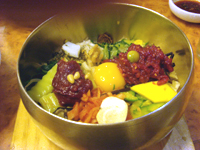
Bibimbap is a very well-known traditional Korean meal in Japan nowadays but one of Jeonju's claims to fame is that it is considered the birthplace of bibimbap. Jeonju bibimbap, Pyonyang Naengmyeon (cold noodles) and Keson kuppa are the gourmet traditions from the Korean dynastic period. Now these three traditional dishes are considered to be intangible cultural treasures, but to Japanese people, it is a familiar dish representative of the cuisine of Korea. Most people probably already know that bibimbap is a dish that is eaten mixed, in other words "bibim" is "mix" and "bap" is rice, or "a dish of rice that is mixed before eating". The bibimbap restaurant that we went to was written as "furumiya" in Japanese but pronounced "Gogun" in Korean. According to the pamphlet, the rice used for bibimbap is cooked in a stock derived from the bones of beef. On top is "fanpokumu" a yellowish vegetable that feels like "Namabu (wheat gluten)" in the mouth. In Japanese, this is called "ryokutou" or green pea jelly and as the name suggests, it is made out of green peas. The sheer variety of items atop the rice reminds one of the rich abundance of the earth enjoyed by the farming community.
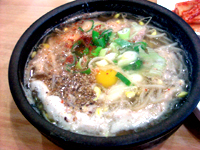
For breakfast, we left the hotel around 8AM to head for a restaurant specializing in bean sprout soup, which was located in a street lined with many restaurants specializing in bean sprout soup. The streets were teeming with people already lined up outside many of the shops before they opened at 9AM on a Sunday morning. We had bean sprout soup called "congnamul kuppa" which has rice in the soup along with kimchi and fried egg as part of the set. It seemed like a typical Korean breakfast, providing a rich, solid start to the day.
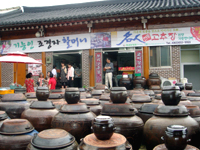
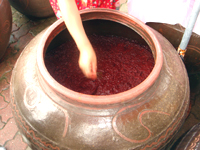
Then from the center of Jeonju, we went about 70km to the south to an area called
Sunchang on to the "Kochujang Village" where many shops making the Korean chili pepper
paste line the street.
Kochujang is a miso-like paste made by fermenting rice malt and hot chili peppers
among other things.
"Kochu" means "hot chili pepper" and "jang" uses the same Chinese character from
"sho yuu" (soy sauce) meaning "seasoning or flavoring."
It is considered to be an integral part of a delicious bibimbap meal.
Ground chili pepper, soybean, wheat, flour, millet, rice malt, miso, salt,
soy sauce and sugar are put in a jar that is about 70-90 centimeters tall and about
50-60 centimeters in diameter and left in the garden or yard.
Normally, the aging process takes about two years but by adjusting the time and
ingredients, a variety of types are available.
The street is filled with shopkeepers beckoning passersby to enter and try
their particular brand of Kochujang.
It is reminiscent of Ajiro on the Izu peninusula where shopkeepers are selling cured fish.
If you go into a shop, you are soon presented with a sample of just about anything you'd like to try.
In trying the various shops, there was the spicy hot to the very sweet with everything in between.
The flavors vary distinctly among the various shops but it is truly a gourmet delight to
sample the different flavors to find the one most suitable.
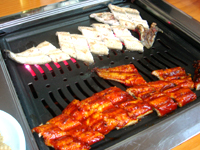
Finally, we tried eel from the Pyeongchang River, which is a delicacy.
Pyeongchang River eel is a freshwater eel that reaches maturity in the freshwater
but goes downstream where the river flows into the ocean.
It is cooked very much on the same style table as a Japanese yakinikuya.
You grill your own meat and then eat it with two different seasonings :
a very lightly salty flavoring and a red, lightly flavored chili pepper seasoning.
There were many menu items not familiar in Japan, making the experience more interesting and enjoyable.
Well, I wonder where it will be next year? Just thinking about it, I am already looking forward to it.
HOME > What’s New > Today's Notables > Details














